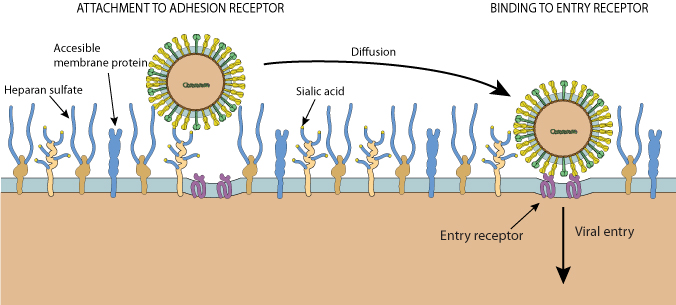Viral attachment to host cell (kw:KW-1161)

Binding to the target host molecule(s) leads to viral genome entry into the host cell, triggers signaling pathways, or allows the virion to be carried by host cells to a specific organ.

Cell receptors to virus can be classified in two classes: adhesion receptors are attaching the virus in a reversible manner to target cells or organs. This adhesion is not mandatory for virus entry, and alone do not trigger entry. Nonetheless it enhances significantly infectivity by concentrating the virus in the vicinity of it's entry receptors. These receptors are triggering virus entry by endocytosis/pinocytosis or by inducing fusion/penetration, and the consequences of this binding are irreversible. They have often be named "co-receptors".
Virus attachment to target cells can involve different partners: -Viral proteins that bind host glycans, receptor proteins, adhesion proteins or peptidases. -Viral glycans that bind host lectins. -Viral lipids that bind host receptor proteins.
Most virus species have one or several host receptor:
dsDNA viruses
ssDNA viruses
dsRNA viruses
ssRNA(+) viruses
ssRNA(-) viruses
ssRNA(RT) viruses
dsRNA(RT) viruses
N.B. In procaryotic viruses, attachment to primary and entry receptors are often referred to as reversible and irreversible adsorption, based on experimental evidences  .
.
Rakhuba DV, Kolomiets EI, Dey ES, Novik GI
Pol J Microbiol. 2010;59(3):145-55
Grove J, Marsh M.
J Cell Biol. 2011 Dec 26;195(7):1071-82
Matching UniProtKB/Swiss-Prot entries
(all links/actions below point to uniprot.org website)0 entry grouped by strain
